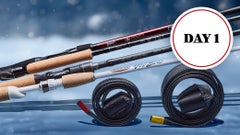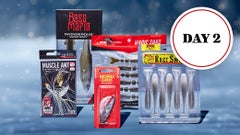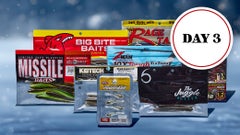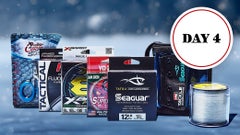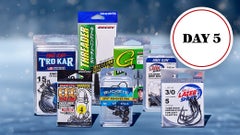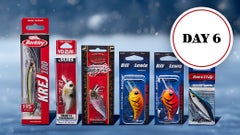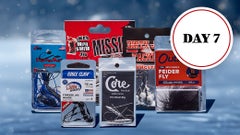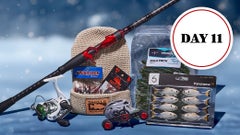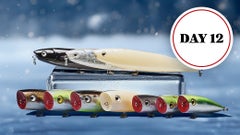Flipping and Pitching
Everyone who has been bass fishing for even a short while knows that bass can be found in almost any depth of water; from 1 foot to 100 feet and everything in between. The techniques and lures used for catching bass at various depths can be very specific and can change when conditions change. Flipping and pitching are techniques used primarily for catching bass in cover in shallow water.
Some bass anglers look at a bank loaded with submerged grass, trees, brush and rocks and think "what a nightmare", while others see fantastic opportunities for catching big bass. If you fall in the former category then the techniques and lures described in this section can help you turn the next nightmare bank into a fish catching opportunity.
Flipping and pitching are rod and line handling techniques that enable the angler to effectively and efficiently work shallow cover from short distances. When applied properly the techniques are very fast and quiet, enabling you to cover lots of water quickly without spooking skinny water bass. There's a wide variety of lures that are effective for these techniques, but the tackle can be pretty specific if you want to optimize your speed covering water and your stealthy presentation.
Shallow water techniques have been used since people first realized that big bass frequently used shallow water ambush points, and that those fish could be caught. Most anglers agree that most of the techniques and tackle were developed on the California Delta. Famous Delta angler Dee Thomas is generally credited as being the driving force behind spreading these ideas into the mainstream angling community.
Rods and Reels
The first thing you'll probably notice about a flipping stick is the length. 7'6" in length is about the standard, but some anglers prefer 7' rods and more and more are progressing to 8' sticks. The extra length on tge 8' rods makes it easier to handle more line and make quieter presentations.
Another thing you'll notice about these rods is that they are generally very stout. They are able to handle line in the 20-30 pound class, and sometimes more. This helps ensure a good solid hookset, but more importantly, it enables the angler to dig a big bass out of some tough, thick, line-cutting cover and get it in the boat without breaking off. More and more anglers are using extremely abrasion resistant lines made with fluorocarbon and super lines with high breaking strengths like Power Pro and Spiderwire.
For flipping, select a rod to match the type of cover and the size of the fish you'll most likely encounter. Start looking in the 7'6" range, even if the rest of your rods are not that long, because to use the technique effectively it requires a long rod. Anglers that are shorter in stature may be more comfortable with a 7' rod. Most anglers, especially taller individuals, can easily handle an 8 footer. Most of these rods have a telescopic butt section so the long rods can collapse and easily fit in the rod locker of your boat. When used properly and locked in place firmly these telescopic rods will not collapse when you are fishing and they are just as strong as one piece rods.
For pitching, most anglers opt for slightly shorter rods, around 7 feet, 6'8"-7'3" being the popular range. The shorter length will help the underhanded delivery necessary for the technique. The rod should feature a flexible tip with lots of backbone to pull big fish from thick cover while delivering the bait precisely on target as noiselessly as possible. Tackle Warehouse has a wide selection of rods from top manufacturers designed for these techniques. For more information call our toll free number.
The reels used for flipping and pitching can be the same reels you use everyday for other techniques but they should be high speed, around 6:1, to pick up line quickly when a fish inhales your bait for a solid hookset and to ensure the big bass cannot turn around in the thick cover and wrap itself up so you cannot get it out. Some popular reels come with a 'flipping switch' which, when engaged, does not allow the thumb bar to lock in free spool, but as soon as you remove your thumb the reel will instantly engage the drive train. This allows for instant hooksets if a fish eats the lure on the fall and you don't have to switch hands and crank the reel to engage before you can set the hook. A variation of this approach and intuitively more versatile is the Double Thumb Bar System offered by Shimano in their Castaic reels. With the Castaic system you can keep the clutch disengaged (the reel will stay in free spool) even when you release the thumb bar, but it can instantly be engaged by pushing the top bar closed for instant hooksets. It also eliminates the possibility of accidentally flicking the flipping switch and having your lure come to a screeching halt when you're casting.
As described above, lines for these techniques should be strong and tough and frequently checked for nicks and scratches throughout the day since you'll be throwing into line damaging cover.
Lures
Bass that pull up into thick cover can be there for a variety of reasons, but feeding seems to be one of the most important. It seems like most of those fish will not turn down a tempting meal. The natural food source that we most often imitate when fishing for these fish is the crayfish, represented by jigs with pork or soft plastic trailers or realistic-looking crawdad baits. However, many flip baits don't seem to resemble anything in the natural world. Worms are also an important flip bait, but the whole new crop of 'creature baits' like the Zoom Brush Hog and other soft plastics that feature legs and tails and flippers are very effective as well. In California the Roboworm 5" Zipper Worm is a very popular flip bait. It often seems that anything you can get into the thick cover without fouling can catch fish. However, some soft plastic baits are not very effective because of their construction; lures with long ribbon-like tails and arms can wrap around sticks, tules, and reeds and not get to where the fish live.
Most flipping jigs feature sharply pointed noses, a good weedguard, full skirts, a big, sharp, thick wire hook and a rattle. Unless you are using pork or plastic chunk trailers you need to make sure the hook is exposed all the way to the head and there is a good 'keeper' or collar to keep the plastic trailer up on the shank of the hook. More than one fish has been missed when the trailer pulled down and covered the hook point. When using soft plastic baits buy premium hooks and make sure you check the points from time to time through out the day to ensure they are sharp and haven't been bent from contact with a rock or other hard structure. Round bend hooks have a wider gap than O'Shaugnessy or Sproat bend hooks and are preferred by most experienced flippers. When using extra wide gap hooks choose heavy wire hooks such as the Gamakatsu Superline or the Owner Extra Wide Gap Plus hooks to be sure the hook will not spring open and lose a big fish when you really need one. Most anglers will peg the weight when Texas-rigging their flip baits so the bait and the weight will not end up on different sides of a branch, which will keep the bait from reaching the fish (see our article on Texas-rigging).
Doing It
Now that you've bought your new flipping stick and the perfect reel to match it and you've got a box full of new flip baits it's time to go out on your favorite bass pond and do it.
We'll start with flipping. Boat position is important for effective flipping. If the cover you are going to fish extends a long way from the shore and you are trying to reach a long way into it, you'll probably have to push the bow right up into the stuff. If the band of brush or other cover is not wide you can keep the boat outside, creating less noise and disturbance, and move down the bank faster, covering more water. If you are fishing with a partner it will probably be more efficient for the front angler to flip the cover closest to the boat and the backseater to work the cover farther in. That way you'll both be fishing 'fresh' water and the front angler will be casting to the nearby targets before the boat arrives, which may spook some shallow fish. Before too long you'll know where the fish are in the cover; right on the outside or deep inside, and you'll waste less time.
For the sake of this description we'll suppose that you are using your right hand to hold the rod. Position the boat the distance you'll be fishing from the cover you've selected, point the rod out away from the boat toward your target and drop the lure to the bottom of the cover the distance from the boat you'll be doing most of your flipping, and engage the reel. The rod should be parallel to the water and at a comfortable height with the lure resting on the bottom and just a little slack in the line. Grab the line loosely with your left hand between the reel and the first guide and pull the line to your left while lifting the rod tip. The bait should be clear of the water and most of the brush. Gently set the bait back in the water and let it flutter to the bottom again in another likely looking ambush point, generally as near to the bush or tree as possible. Watch your line closely; sometimes the only indication you'll have that you've been bit is the line jumping or moving. Shake or hop the lure for a second or two and repeat. Now you see the advantage of the long rod; you can reach 8 or 9 feet from the boat without swinging the lure or casting which will make you more efficient in covering water and give the lure a quieter entry. To reach further into the cover, let out a little more line and swing the lure away from you and let it gently set down on the water. Again, without the time consuming mechanics of casting and retrieving your bait you can fish every bit of cover 10 or even 15 feet from the boat. Now suppose you are in a shallow area with scattered cover and you want to flip to stumps, isolated clumps of grass, or bushes. It may be more efficient to move the boat in a straight line and pitch your lure to the isolated cover instead of moving from spot to spot. Pitching takes a little more control of your equipment but when executed correctly you can cast quite a long distance and land the lure in the water almost noiselessly. Again, we'll suppose you are holding your rod in your right hand. With the tip of the rod pointing up you should disengage the reel and let out enough line so the lure hangs down to about the level of the reel. Grab the lure with your left hand and hold the butt of the rod up near your shoulder with the tip pointing down. Your left hand with the lure should be just about hanging down at your side. Now comes the tricky part. Release the lure and lift the rod tip at the same time so the lure accelerates through a downward swing toward your target. The lure should be just above the surface of the water when it reaches the bottom of the downward swing. When the lure is travelling parallel to the surface of the water you should let the line run off the spool. If you time your releease correctly the lure will continue travelling parallel to the water. Don't allow the line to go slack, you're not trying to throw the lure forward but swing it, and don't allow the lure to hit the water during the swing, you'll get a nasty backlash. With practice you'll be able to keep the bait just inches from the surface of the water, stop it exactly above the target and let it slip quietly into the water. Let line out as the bait falls through the water so it will drop straight down instead of penduluming back toward you. Reel in until the lure is about equal with the reel and pitch again. The advantage of this technique over sidearm or overhand casting is that you can learn to make the lure enter the water virtually without a splash, and your accuracy can be fantastic.
Try these techniques the next time you get a chance, but practice at home before you go out to minimize your frustration if you don't get it right the first time. The best pro bass anglers have great instincts and knowledge, but they wouldn't be at the top levelif hey couldn't cast, flip, and pitch accurately and position the boat correctly. It takes great instincts and superb mechanics to turn good into great.

